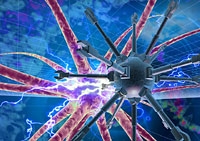I stumbled across an essay, Nano-Bio-Info-Cogno Skin by Natasha Vita-More on the IEET (Institute for Ethics & Emerging Technologies) website newly republished on Mar. 19, 2012. (The essay was originally published Jan. 19, 2009 on the Nanotechnology Now website.) No matter the date, it has proved quite timely in light of Nokia’s (Finnish telephone company) application to patent magnetic tattoos. From the Vibrating tattoo alerts patent filed by Nokia in US March 20, 2012 story on the BBC News online,
Vibrating magnetic tattoos may one day be used to alert mobile phone users to phone calls and text messages if Nokia follows up a patent application.
The Finnish company has described the idea in a filing to the US Patent and Trademark Office.
It describes tattooing, stamping or spraying “ferromagnetic” material onto a user’s skin and then pairing it with a mobile device.
It suggests different vibrations could be used to create a range of alerts.
The application is dated March 15, 2012. From United States Patent Application no. 20120062371 (abstract),
1. An apparatus comprising: a material attachable to skin, the material capable of detecting a magnetic field and transferring a perceivable stimulus to the skin, wherein the perceivable stimulus relates to the magnetic field.
2. An apparatus according to claim 1, wherein the material comprises at least one of a visible image, invisible image, invisible tattoo, visible tattoo, visible marking, invisible marking, visible marker, visible sign, invisible sign, visible label, invisible label, visible symbol, invisible symbol, visible badge and invisible badge.
3. An apparatus according to claim 1, wherein the perceivable stimulus comprises vibration.
4. An apparatus according to claim 1, wherein the magnetic field originates from an electronic device and relates to digital content stored in the electronic device.
5. An apparatus according to claim 1, wherein the perceivable stimulus is related to the magnetic field.
6. An apparatus according to claim 1, wherein the perceivable stimulus relates to a time variation of at least one of a magnetic field pulse, height, width and period.
7. An apparatus according to claim 1, wherein the magnetic field originates from a remote source.
8. An apparatus according to claim 7, wherein the perceivable stimulus relates to digital content of the remote source.
If you want the full listing, there are 13 more claims for a total of 21 listed in the abstract. Nokia’s initial plans are to create a material that you’d wear, the notion of tattoos arises later in the application according to Vlad Bobleanta in his March 15, 2012 article for unwiredview.com. He describes the potential tattoos is some detail,
The tattoo would be applied using ferromagnetic inks. The ink material would first be exposed to high temperatures to demagnetize it. Then the tattoo would be applied. You’ll apparently be able to choose the actual image you want as the tattoo. The procedure is identical to that of getting a ‘normal’ tattoo – only the ink is special.
After the tattoo has been applied, you’ll need to magnetize it. That means bringing the tattooed area in the close proximity of an external magnet, and going “several times over this magnet to magnetize the image material again”. The tattoo will then have enhanced sensitivity towards external alternating magnet fields, and will basically function the same way the aforementioned material attached to your skin did. Only in a more permanent fashion, so to speak.
I suggest reading Bobleanta’s article as he includes diagrams of the proposed tattoo, fabric, and fingernail applications. Yes, this could be attached to your fingernails.
Getting back to Vita-More’s essay, she was exploring the integration of nanotechnology, biotechnology, cognitive and neuro sciences (nano-bio-info-cogno- or NBIC) as applied to skin (from the essay),
NBIC is a far cry from the biological touch, taste and smell of our skin because it suggests a cold, mechanical and invasive integration. While the cognitive and neuro sciences are a bit more familiar from a biological viewpoint, they too suggest tampering with our thoughts and probing our privacy. Nonetheless, the enhancement of our human skin is not only lifesaving; it offers new textures, sensations and smells which will have their own sensorial capabilities. [emphasis mine]
New sensorial capabilities certainly evokes Nokia’s proposed magnetic tattoo. She also comments from an artist’s perspective,
What does this mean for designers and media artists? From the perspective of my own artistic practice, it means that it is natural that humans integrate with other types of organisms, that we will evolve with other types of systems, and that this evolution is essential for our future.
The idea of fusing skin with technology is not new as you can see from Vita-More’s essay and countless science fiction stories, as well, there’s research of this kind being done globally. For example, there’s research on electronic tattoos as I noted in my Aug. 12, 2011 posting (and you can find more references elsewhere online). However, these magnetic tattoos represent the first time I’ve seen interest from a commercial enterprise.
